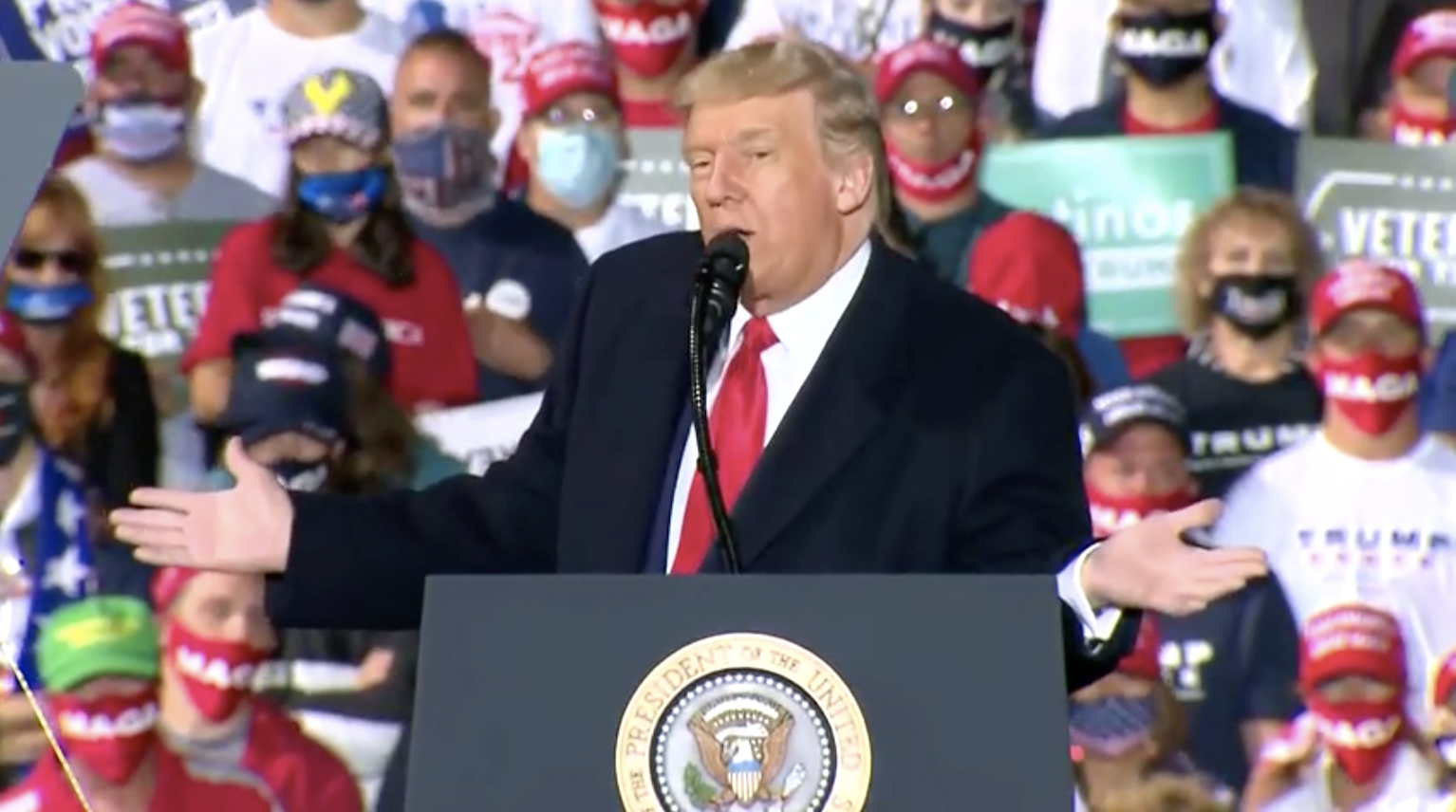Until recently deemed irrevocably in Donald Trump’s column, Ohio has been thrown into play as November’s election hurtles near.
A series of opinion polls since the spring have put Trump neck and neck with Joe Biden. Analysts say that makes Ohio a mineshaft canary for the president’s reelection, regardless of whether he ultimately carries the state.
“A close outcome in Ohio means that Trump has lost enough support in the Midwest that he will lose the states he really needs,” says Kyle Kondik, an expert on Ohio politics and elections.
That both parties wrote off the state as a battleground this year seemed logical. After all, Republicans hold the governor’s mansion, the legislature, every senior elected state office, one U.S. Senate seat, and all but two of 16 U.S. congressional districts.
Trump won the state last time by eight points, more than double Barack Obama’s margin of victory four years earlier. Hillary Clinton won all the state’s major cities except Dayton, which she lost by a hair. But Trump carried all but eight of Ohio’s 88 counties, and overwhelmingly in the more rural ones.
The results in 2016 painted Ohio’s political map as a strawberry tart sprinkled with a handful of blueberries. But things may have changed. If the state really is up for grabs, it is owed to a congealing and unstable brew of defecting conservatives, disgusted suburbanites, and pacified progressives.
Last November, the Spectator alerted readers to the real possibility of a Democratic comeback in Ohio and nearby states, the prospects for which would improve if the party’s primaries produced a moderate like Biden.
Despite some defections, polling suggests most rural voters and working-class white voters remain with the president. But urban liberals, many of whom stayed home four years ago to spite Clinton, appear ready to turn out for Biden. Suburban voters, especially women put off by Trump as a person, may tip the balance.
“Joe Biden might not have been their first choice, but maybe he was their third choice, and that’s good enough for them,” says Bill Wood, a magazine editor and founding member of a progressive political group in the booming Columbus suburb of Westerville. “There couldn’t be bigger difference between the two parties.”
While losing the national popular vote by three million ballots, Trump gained the White House with the electoral votes of Michigan, Pennsylvania, and Wisconsin. He carried each state, whose demographics and voter concerns resemble Ohio’s, by less than a percentage point.
An August poll of polls by FiveThirtyEight, a statistical analytics firm, showed Biden ahead in Ohio by the thinnest of margins. In comparison, the website had Biden leading in Michigan by more than seven points; in Wisconsin and Pennsylvania by more than six.
Many expect those three Midwestern states, and perhaps a few others, to decide November’s contest.
“Ohio is going to vote to the right of the nation again,” says Kondik, the elections expert. “If it is close either way, that suggests that Trump is losing.”
Although many see this November’s vote as a referendum on Trump, the state Republican Party has troubles of its own, after years of complete political control.
Governor Mike DeWine remains popular for his handling of the pandemic. But the party was rocked in July when Larry Householder, the powerful speaker of the state legislature, was indicted on charges of taking $60 million in bribes to pass legislation favoring a utility.
“People are questioning the current direction of the Republican Party and are open to voting for the alternative,” Wood says. “We see it in people we talk to, neighbors who have been reliably Republican in the past. It will have a very significant effect in towns that are traditionally Republican.”
A late-July survey by the Bliss Institute, a think tank at the University of Akron, put Biden four points ahead, 46 to 42, just outside the margin of error.
“Without a doubt, Ohio is a battleground,” says political scientist David Cohen, the institute’s acting director.
One newspaper’s illustration of the survey results shows Biden’s support cutting across Ohio like a multihued sash—from the deep-blue Cleveland area in the northeast to the robin-egg tint in the erstwhile Republican redoubt of metropolitan Cincinnati in the south.
“The suburbs are now pretty rapidly changing from being a strength of Republicanism to being a bastion of the Democrats,” Cohen says. “Educated women, especially in the suburbs, are disgusted by Trump’s language. It’s not only in Ohio: people across the country are tired of the craziness.”
Barb Lewis, a conservative Republican county commissioner in the suburbs north of Columbus, agrees.
“We’re seeing a huge gender gap,” Lewis says of the more prosperous and growing communities in her Delaware County. “There certainly is a reticence among people because of the president’s personal style.”
But Lewis, a political scientist who taught election campaigns at Ohio State University, says those suburbanites’ disdain of Trump as a person could be overcome by support for the conservative judges he’s appointed and economic policies he’s favored. Fear of crime and protest violence—in Portland, Seattle, Minneapolis, and Kenosha, Wisconsin—could erode white suburban support for racial equality efforts, a major Democratic theme.
“When their personal safety is at stake, they will vote for whoever will protect them,” Lewis says. Not surprisingly, an ad blitz by the Trump campaign played to those worries, warning viewers that “you won’t be safe in Joe Biden’s America.”
Both Biden and Kamala Harris have been criticized by more left-leaning Democrats and independents for their records of being tough on crime. That may help them fend off Trump’s demagogic attacks.
But Lewis says that many voters in her suburban world may still vote for Trump but be unwilling to talk about it with anyone but their closest family and friends. “If they say they are for Trump, then they will have to defend it immediately,” she says.
Clinton garnered some 300,000 fewer votes in Ohio in 2016 than Obama did in 2012. Trump, in turn, bested Mitt Romney’s turnout by nearly a quarter-million votes.
Trump excited white rural and working-class urban voters. Many others who lean Democratic either voted for him or stayed home to spite Clinton, figuring she would easily win.
With November’s vote a clear referendum on Trump—and Sanders publicly supporting Biden—the rifts in the Democratic ranks have been healed for now, analysts and Democratic operatives say.
“I see some semblance of getting in line and behind the ticket,” says Chris Redfern, who resigned his nine-year chairmanship of the state’s squabbling Democratic Party after Republicans swept state elections in 2014. “This thing is baked. I don’t know many undecided voters. Biden wins.”
Most white working-class voters, who exit polls suggest make up more than half of the electorate, will likely stick with Trump, says Dave Betras, a longtime Democratic operative in Mahoning County, which anchors Ohio’s battered steel industry.
Clinton barely won the county, which includes the once reliably blue and union city of Youngstown, while Trump surged. Signs supporting Trump, many of them handmade, flourish in yards across the region this summer, Betras said, eclipsing the few backing Biden.
“I’ve never seen anyone defy political gravity like he does,” Betras says. “He’s the smartest stupid person I know. He has a talent and a knack to feel the mood. He seems to know what feeds the bad angels on people’s backs.”
“They say they know he’s crazy,” Betras says of Trump backers he knows. “They don’t care.”
Maybe they don’t. But Chris Gibbs, a longtime Republican stalwart in southwestern Ohio, does.
Gibbs, a 62-year-old former Republican county chairman and election board president, says he reluctantly jumped aboard the train after Trump won the 2016 nomination. Though disgruntled by trade tensions that sapped grain exports, Gibbs consoled himself with Trump’s judicial appointments and regulatory rollbacks.
He finally stepped off the train, Gibbs says, when Trump kowtowed to Vladimir Putin at their 2018 Helsinki summit.
“The Republican Party was a welcoming place, where disparate views were brought together,” Gibbs said of his old political home. “Everyone had the opportunity to be heard. Today’s Republican Party has no resemblance to that. It’s a populist cult that’s all about tearing down.”
Now Gibbs and a handful of other conservatives have founded Operation Grant, a local affiliate of the Lincoln Project, the movement of never-Trump conservatives that has been churning out damning ads against Trump.
He and his fellow Ohio deserters—all locally prominent Republicans—have no illusions about swaying a majority of their party against Trump. John Kasich, the conservative and once-popular former Ohio governor who has endorsed Biden, is widely vilified by Ohio Republicans.
Gibbs and his colleagues just hope to convince enough Republicans to make a difference.
“To me, this is a matter of conscience,” says Phil Heimlich, a Cincinnati lawyer who has served as a Republican city and county commissioner.
“There are a significant number of Republicans in this state who are fed up with Trump,” says Heimlich. “These are the people we are trying to reach. We’re saying to them, let’s put country first and party second. The man is a danger to the country and a threat to democracy.”
For his part, Gibbs points to polling that suggests Trump’s support in rural voters has been cut from about 30 points to nine.
“There is still strong support of the president. These are conservative people,” Gibbs say of his neighbors in Shelby County, a rural county north of Dayton that gave Trump 78 percent of the vote. “But everybody has their internal red lines. We are trying to get the word out in rural communities that it is OK to change your mind. . . . You can stand up.”
As a staff correspondent for the Houston Chronicle, The Wall Street Journal, and other newspapers, Dudley Althaus has spent his career reporting on politics and other issues in Texas, the U.S.-Mexico border, and across Latin America.







0 Comments